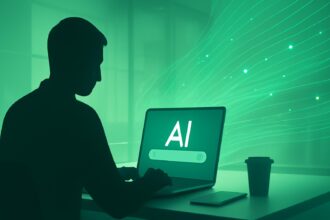OpenAI’s strategic alignment with Broadcom signifies a major leap in AI infrastructure investment, reinforcing the company’s position at the forefront of AI innovation. The scale and scope of this hardware acquisition will provide OpenAI with enhanced control over performance optimization and supply chain security. !-- wp:paragraph -->
Contents
Industry OutlookFinOracleAI — Market ViewIndustry OutlookFinOracleAI — Market ViewStrategic Implications for AI InfrastructureIndustry OutlookFinOracleAI — Market ViewStrategic Implications for AI InfrastructureIndustry OutlookFinOracleAI — Market ViewStrategic Implications for AI InfrastructureIndustry OutlookFinOracleAI — Market ViewDeal Financials and Industry ContextStrategic Implications for AI InfrastructureIndustry OutlookFinOracleAI — Market ViewDeal Financials and Industry ContextStrategic Implications for AI InfrastructureIndustry OutlookFinOracleAI — Market ViewOpenAI Partners with Broadcom to Deploy 10GW of Custom AI HardwareDeal Financials and Industry ContextStrategic Implications for AI InfrastructureIndustry OutlookFinOracleAI — Market View
- Opportunities: Custom hardware design tailored to AI workloads can drive efficiency gains and enable more complex model architectures.
- Risks: The enormous capital expenditure and reliance on semiconductor partners pose financial and operational risks, especially amid global chip supply uncertainties.
- Potential to set new industry standards for AI hardware integration and performance benchmarks.
- Acceleration of AI model development cycles through optimized hardware-software co-design.
“By designing its own chips and systems, OpenAI can embed what it’s learned from developing frontier models and products directly into the hardware, unlocking new levels of capability and intelligence,” OpenAI said in its statement.Industry Outlook
- OpenAI’s partnerships with Broadcom, AMD, Nvidia, and potentially Oracle represent a multi-pronged strategy to secure vast computational resources.
- These investments highlight the intensifying competition for AI hardware capacity amid rapid model scaling.
- Custom AI accelerators are becoming essential to support next-generation AI applications requiring unprecedented speed and efficiency.
- Broader market implications include increased demand for semiconductor manufacturing and supply chain resilience.
FinOracleAI — Market View
OpenAI’s strategic alignment with Broadcom signifies a major leap in AI infrastructure investment, reinforcing the company’s position at the forefront of AI innovation. The scale and scope of this hardware acquisition will provide OpenAI with enhanced control over performance optimization and supply chain security. !-- wp:paragraph -->- Opportunities: Custom hardware design tailored to AI workloads can drive efficiency gains and enable more complex model architectures.
- Risks: The enormous capital expenditure and reliance on semiconductor partners pose financial and operational risks, especially amid global chip supply uncertainties.
- Potential to set new industry standards for AI hardware integration and performance benchmarks.
- Acceleration of AI model development cycles through optimized hardware-software co-design.
“By designing its own chips and systems, OpenAI can embed what it’s learned from developing frontier models and products directly into the hardware, unlocking new levels of capability and intelligence,” OpenAI said in its statement.Industry Outlook
- OpenAI’s partnerships with Broadcom, AMD, Nvidia, and potentially Oracle represent a multi-pronged strategy to secure vast computational resources.
- These investments highlight the intensifying competition for AI hardware capacity amid rapid model scaling.
- Custom AI accelerators are becoming essential to support next-generation AI applications requiring unprecedented speed and efficiency.
- Broader market implications include increased demand for semiconductor manufacturing and supply chain resilience.
FinOracleAI — Market View
OpenAI’s strategic alignment with Broadcom signifies a major leap in AI infrastructure investment, reinforcing the company’s position at the forefront of AI innovation. The scale and scope of this hardware acquisition will provide OpenAI with enhanced control over performance optimization and supply chain security. !-- wp:paragraph -->- Opportunities: Custom hardware design tailored to AI workloads can drive efficiency gains and enable more complex model architectures.
- Risks: The enormous capital expenditure and reliance on semiconductor partners pose financial and operational risks, especially amid global chip supply uncertainties.
- Potential to set new industry standards for AI hardware integration and performance benchmarks.
- Acceleration of AI model development cycles through optimized hardware-software co-design.
Strategic Implications for AI Infrastructure
OpenAI’s decision to co-design custom AI accelerators with Broadcom reflects a broader industry trend toward vertically integrated hardware tailored to specific AI workloads. By controlling chip design and deployment, OpenAI can optimize performance, reduce latency, and potentially lower operational costs. !-- wp:paragraph --> This approach aims to support increasingly complex AI models that demand massive computational power and specialized hardware architectures. The scale of this partnership underscores the critical role of hardware innovation in maintaining competitive advantages in AI research and deployment. !-- wp:paragraph -->“By designing its own chips and systems, OpenAI can embed what it’s learned from developing frontier models and products directly into the hardware, unlocking new levels of capability and intelligence,” OpenAI said in its statement.Industry Outlook
- OpenAI’s partnerships with Broadcom, AMD, Nvidia, and potentially Oracle represent a multi-pronged strategy to secure vast computational resources.
- These investments highlight the intensifying competition for AI hardware capacity amid rapid model scaling.
- Custom AI accelerators are becoming essential to support next-generation AI applications requiring unprecedented speed and efficiency.
- Broader market implications include increased demand for semiconductor manufacturing and supply chain resilience.
FinOracleAI — Market View
OpenAI’s strategic alignment with Broadcom signifies a major leap in AI infrastructure investment, reinforcing the company’s position at the forefront of AI innovation. The scale and scope of this hardware acquisition will provide OpenAI with enhanced control over performance optimization and supply chain security. !-- wp:paragraph -->- Opportunities: Custom hardware design tailored to AI workloads can drive efficiency gains and enable more complex model architectures.
- Risks: The enormous capital expenditure and reliance on semiconductor partners pose financial and operational risks, especially amid global chip supply uncertainties.
- Potential to set new industry standards for AI hardware integration and performance benchmarks.
- Acceleration of AI model development cycles through optimized hardware-software co-design.
Strategic Implications for AI Infrastructure
OpenAI’s decision to co-design custom AI accelerators with Broadcom reflects a broader industry trend toward vertically integrated hardware tailored to specific AI workloads. By controlling chip design and deployment, OpenAI can optimize performance, reduce latency, and potentially lower operational costs. !-- wp:paragraph --> This approach aims to support increasingly complex AI models that demand massive computational power and specialized hardware architectures. The scale of this partnership underscores the critical role of hardware innovation in maintaining competitive advantages in AI research and deployment. !-- wp:paragraph -->“By designing its own chips and systems, OpenAI can embed what it’s learned from developing frontier models and products directly into the hardware, unlocking new levels of capability and intelligence,” OpenAI said in its statement.Industry Outlook
- OpenAI’s partnerships with Broadcom, AMD, Nvidia, and potentially Oracle represent a multi-pronged strategy to secure vast computational resources.
- These investments highlight the intensifying competition for AI hardware capacity amid rapid model scaling.
- Custom AI accelerators are becoming essential to support next-generation AI applications requiring unprecedented speed and efficiency.
- Broader market implications include increased demand for semiconductor manufacturing and supply chain resilience.
FinOracleAI — Market View
OpenAI’s strategic alignment with Broadcom signifies a major leap in AI infrastructure investment, reinforcing the company’s position at the forefront of AI innovation. The scale and scope of this hardware acquisition will provide OpenAI with enhanced control over performance optimization and supply chain security. !-- wp:paragraph -->- Opportunities: Custom hardware design tailored to AI workloads can drive efficiency gains and enable more complex model architectures.
- Risks: The enormous capital expenditure and reliance on semiconductor partners pose financial and operational risks, especially amid global chip supply uncertainties.
- Potential to set new industry standards for AI hardware integration and performance benchmarks.
- Acceleration of AI model development cycles through optimized hardware-software co-design.
Strategic Implications for AI Infrastructure
OpenAI’s decision to co-design custom AI accelerators with Broadcom reflects a broader industry trend toward vertically integrated hardware tailored to specific AI workloads. By controlling chip design and deployment, OpenAI can optimize performance, reduce latency, and potentially lower operational costs. !-- wp:paragraph --> This approach aims to support increasingly complex AI models that demand massive computational power and specialized hardware architectures. The scale of this partnership underscores the critical role of hardware innovation in maintaining competitive advantages in AI research and deployment. !-- wp:paragraph -->“By designing its own chips and systems, OpenAI can embed what it’s learned from developing frontier models and products directly into the hardware, unlocking new levels of capability and intelligence,” OpenAI said in its statement.Industry Outlook
- OpenAI’s partnerships with Broadcom, AMD, Nvidia, and potentially Oracle represent a multi-pronged strategy to secure vast computational resources.
- These investments highlight the intensifying competition for AI hardware capacity amid rapid model scaling.
- Custom AI accelerators are becoming essential to support next-generation AI applications requiring unprecedented speed and efficiency.
- Broader market implications include increased demand for semiconductor manufacturing and supply chain resilience.
FinOracleAI — Market View
OpenAI’s strategic alignment with Broadcom signifies a major leap in AI infrastructure investment, reinforcing the company’s position at the forefront of AI innovation. The scale and scope of this hardware acquisition will provide OpenAI with enhanced control over performance optimization and supply chain security. !-- wp:paragraph -->- Opportunities: Custom hardware design tailored to AI workloads can drive efficiency gains and enable more complex model architectures.
- Risks: The enormous capital expenditure and reliance on semiconductor partners pose financial and operational risks, especially amid global chip supply uncertainties.
- Potential to set new industry standards for AI hardware integration and performance benchmarks.
- Acceleration of AI model development cycles through optimized hardware-software co-design.
Deal Financials and Industry Context
While OpenAI and Broadcom have not disclosed the terms of their agreement, estimates from the Financial Times suggest the partnership could cost between $350 billion and $500 billion. This positions the deal among the largest AI infrastructure investments to date. !-- wp:paragraph --> This announcement follows a series of significant infrastructure agreements by OpenAI. Last week, the company secured an additional six gigawatts of chip capacity from AMD in a deal valued at tens of billions of dollars. Earlier, Nvidia committed $100 billion in investment to OpenAI and agreed to provide 10 gigawatts of hardware. !-- wp:paragraph --> In September, reports surfaced of an unprecedented $300 billion cloud infrastructure deal between OpenAI and Oracle, although neither party has officially confirmed the arrangement. !-- wp:paragraph -->Strategic Implications for AI Infrastructure
OpenAI’s decision to co-design custom AI accelerators with Broadcom reflects a broader industry trend toward vertically integrated hardware tailored to specific AI workloads. By controlling chip design and deployment, OpenAI can optimize performance, reduce latency, and potentially lower operational costs. !-- wp:paragraph --> This approach aims to support increasingly complex AI models that demand massive computational power and specialized hardware architectures. The scale of this partnership underscores the critical role of hardware innovation in maintaining competitive advantages in AI research and deployment. !-- wp:paragraph -->“By designing its own chips and systems, OpenAI can embed what it’s learned from developing frontier models and products directly into the hardware, unlocking new levels of capability and intelligence,” OpenAI said in its statement.Industry Outlook
- OpenAI’s partnerships with Broadcom, AMD, Nvidia, and potentially Oracle represent a multi-pronged strategy to secure vast computational resources.
- These investments highlight the intensifying competition for AI hardware capacity amid rapid model scaling.
- Custom AI accelerators are becoming essential to support next-generation AI applications requiring unprecedented speed and efficiency.
- Broader market implications include increased demand for semiconductor manufacturing and supply chain resilience.
FinOracleAI — Market View
OpenAI’s strategic alignment with Broadcom signifies a major leap in AI infrastructure investment, reinforcing the company’s position at the forefront of AI innovation. The scale and scope of this hardware acquisition will provide OpenAI with enhanced control over performance optimization and supply chain security. !-- wp:paragraph -->- Opportunities: Custom hardware design tailored to AI workloads can drive efficiency gains and enable more complex model architectures.
- Risks: The enormous capital expenditure and reliance on semiconductor partners pose financial and operational risks, especially amid global chip supply uncertainties.
- Potential to set new industry standards for AI hardware integration and performance benchmarks.
- Acceleration of AI model development cycles through optimized hardware-software co-design.
Deal Financials and Industry Context
While OpenAI and Broadcom have not disclosed the terms of their agreement, estimates from the Financial Times suggest the partnership could cost between $350 billion and $500 billion. This positions the deal among the largest AI infrastructure investments to date. !-- wp:paragraph --> This announcement follows a series of significant infrastructure agreements by OpenAI. Last week, the company secured an additional six gigawatts of chip capacity from AMD in a deal valued at tens of billions of dollars. Earlier, Nvidia committed $100 billion in investment to OpenAI and agreed to provide 10 gigawatts of hardware. !-- wp:paragraph --> In September, reports surfaced of an unprecedented $300 billion cloud infrastructure deal between OpenAI and Oracle, although neither party has officially confirmed the arrangement. !-- wp:paragraph -->Strategic Implications for AI Infrastructure
OpenAI’s decision to co-design custom AI accelerators with Broadcom reflects a broader industry trend toward vertically integrated hardware tailored to specific AI workloads. By controlling chip design and deployment, OpenAI can optimize performance, reduce latency, and potentially lower operational costs. !-- wp:paragraph --> This approach aims to support increasingly complex AI models that demand massive computational power and specialized hardware architectures. The scale of this partnership underscores the critical role of hardware innovation in maintaining competitive advantages in AI research and deployment. !-- wp:paragraph -->“By designing its own chips and systems, OpenAI can embed what it’s learned from developing frontier models and products directly into the hardware, unlocking new levels of capability and intelligence,” OpenAI said in its statement.Industry Outlook
- OpenAI’s partnerships with Broadcom, AMD, Nvidia, and potentially Oracle represent a multi-pronged strategy to secure vast computational resources.
- These investments highlight the intensifying competition for AI hardware capacity amid rapid model scaling.
- Custom AI accelerators are becoming essential to support next-generation AI applications requiring unprecedented speed and efficiency.
- Broader market implications include increased demand for semiconductor manufacturing and supply chain resilience.
FinOracleAI — Market View
OpenAI’s strategic alignment with Broadcom signifies a major leap in AI infrastructure investment, reinforcing the company’s position at the forefront of AI innovation. The scale and scope of this hardware acquisition will provide OpenAI with enhanced control over performance optimization and supply chain security. !-- wp:paragraph -->- Opportunities: Custom hardware design tailored to AI workloads can drive efficiency gains and enable more complex model architectures.
- Risks: The enormous capital expenditure and reliance on semiconductor partners pose financial and operational risks, especially amid global chip supply uncertainties.
- Potential to set new industry standards for AI hardware integration and performance benchmarks.
- Acceleration of AI model development cycles through optimized hardware-software co-design.
OpenAI Partners with Broadcom to Deploy 10GW of Custom AI Hardware
OpenAI has announced a landmark partnership with semiconductor giant Broadcom to develop and deploy 10 gigawatts of custom AI accelerator hardware. This substantial infrastructure build-out is set to begin in 2026 and continue through 2029, enhancing OpenAI’s data centers and those of its partners. !-- wp:paragraph --> By designing bespoke chips and systems tailored to its advanced AI models, OpenAI aims to embed its deep expertise directly into hardware, unlocking new capabilities and increasing computational efficiency, the company stated in a recent press release. !-- wp:paragraph -->Deal Financials and Industry Context
While OpenAI and Broadcom have not disclosed the terms of their agreement, estimates from the Financial Times suggest the partnership could cost between $350 billion and $500 billion. This positions the deal among the largest AI infrastructure investments to date. !-- wp:paragraph --> This announcement follows a series of significant infrastructure agreements by OpenAI. Last week, the company secured an additional six gigawatts of chip capacity from AMD in a deal valued at tens of billions of dollars. Earlier, Nvidia committed $100 billion in investment to OpenAI and agreed to provide 10 gigawatts of hardware. !-- wp:paragraph --> In September, reports surfaced of an unprecedented $300 billion cloud infrastructure deal between OpenAI and Oracle, although neither party has officially confirmed the arrangement. !-- wp:paragraph -->Strategic Implications for AI Infrastructure
OpenAI’s decision to co-design custom AI accelerators with Broadcom reflects a broader industry trend toward vertically integrated hardware tailored to specific AI workloads. By controlling chip design and deployment, OpenAI can optimize performance, reduce latency, and potentially lower operational costs. !-- wp:paragraph --> This approach aims to support increasingly complex AI models that demand massive computational power and specialized hardware architectures. The scale of this partnership underscores the critical role of hardware innovation in maintaining competitive advantages in AI research and deployment. !-- wp:paragraph -->“By designing its own chips and systems, OpenAI can embed what it’s learned from developing frontier models and products directly into the hardware, unlocking new levels of capability and intelligence,” OpenAI said in its statement.Industry Outlook
- OpenAI’s partnerships with Broadcom, AMD, Nvidia, and potentially Oracle represent a multi-pronged strategy to secure vast computational resources.
- These investments highlight the intensifying competition for AI hardware capacity amid rapid model scaling.
- Custom AI accelerators are becoming essential to support next-generation AI applications requiring unprecedented speed and efficiency.
- Broader market implications include increased demand for semiconductor manufacturing and supply chain resilience.
FinOracleAI — Market View
OpenAI’s strategic alignment with Broadcom signifies a major leap in AI infrastructure investment, reinforcing the company’s position at the forefront of AI innovation. The scale and scope of this hardware acquisition will provide OpenAI with enhanced control over performance optimization and supply chain security. !-- wp:paragraph -->- Opportunities: Custom hardware design tailored to AI workloads can drive efficiency gains and enable more complex model architectures.
- Risks: The enormous capital expenditure and reliance on semiconductor partners pose financial and operational risks, especially amid global chip supply uncertainties.
- Potential to set new industry standards for AI hardware integration and performance benchmarks.
- Acceleration of AI model development cycles through optimized hardware-software co-design.













